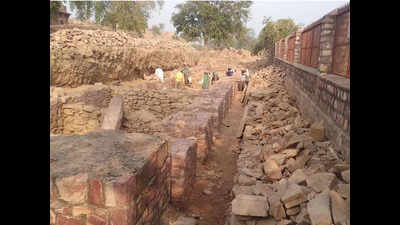Trending
This story is from February 4, 2019
Dozen 17th century Mughal-era shops to be the latest tourist attraction at Fatehpur Sikri
Archeological Survey of India (ASI) excavated a “shopping complex”, with a dozen shops of 17th century Mughal-era, near the museum in Fatehpur Sikri last month.

The conservation work of these shops that even have ramps has been started by the ASI team and the same will be opened to tourists in June this year.
Key Highlights
- ASI excavates a “shopping complex”, with a dozen shops of 17th century Mughal-era, near the museum in Fatehpur Sikri last month.
- ASI (Agra circle) superintending archeologist Vasant K Swarankar said that these shops are double-storey and are located in an area of 34 meters.
- Fatehpur Sikri served as Akbar’s capital for 13 years, from 1572 to 1585.
AGRA: Archeological Survey of India (ASI) excavated a “shopping complex”, with a dozen shops of 17th century Mughal-era, near the museum in Fatehpur Sikri last month.
The conservation work of these shops that even have ramps has been started by the ASI team and the same will be opened to tourists in June this year.

Confirming this, ASI (Agra circle) superintending archeologist Vasant K Swarankar said that these shops are double-storey and are located in an area of 34 meters.He said scientific clearance work is still going on and some more excavations will be carried out as they had an approval for digging an area of 102 meters.

He told TOI that the masonry and architectural evidences confirm that they are from the Mughal-era.

Giving details about excavation work, conservation assistant (Agra circle) Kalandhar Bind said that plaster of lime mortar (composed of lime and an aggregate such as sand, mixed with water) was found. “We will also use this for arranging the broken cells or shops,” said Kalandhar, adding that the ancient Egyptians were the first to use lime mortars. About 6,000 years ago, they used lime to plaster the pyramids at Giza.

He said course rubble stones, random rubble stones and slabs of red sand stones were found during scientific clearance. He said, “pitching will be done to fill the joints”. He added that these all were unearthed after digging the soil of 2.5 meters.

Fatehpur Sikri served as Akbar’s capital for 13 years, from 1572 to 1585. After his military victories over Chittor and Ranthambore, Akbar decided to shift his capital from Agra to a new location for a variety of reasons, including honouring sufi saint Salim Chishti. In the next 15 years, he built a series of royal palaces, harem, courts, a mosque, private quarters and other utility buildings here. But as fortune had it, the Imperial complex was abandoned in 1585, shortly after its completion, again due to a variety of reasons, but mainly paucity of water. The capital was shifted to Lahore before Akbar moved back to Agra. A Mughal architecture in India, Sikri Fort was declared a UNESCO world heritage site in 1986.

The conservation work of these shops that even have ramps has been started by the ASI team and the same will be opened to tourists in June this year.

Confirming this, ASI (Agra circle) superintending archeologist Vasant K Swarankar said that these shops are double-storey and are located in an area of 34 meters.He said scientific clearance work is still going on and some more excavations will be carried out as they had an approval for digging an area of 102 meters.

He told TOI that the masonry and architectural evidences confirm that they are from the Mughal-era.

Giving details about excavation work, conservation assistant (Agra circle) Kalandhar Bind said that plaster of lime mortar (composed of lime and an aggregate such as sand, mixed with water) was found. “We will also use this for arranging the broken cells or shops,” said Kalandhar, adding that the ancient Egyptians were the first to use lime mortars. About 6,000 years ago, they used lime to plaster the pyramids at Giza.

He said course rubble stones, random rubble stones and slabs of red sand stones were found during scientific clearance. He said, “pitching will be done to fill the joints”. He added that these all were unearthed after digging the soil of 2.5 meters.

Fatehpur Sikri served as Akbar’s capital for 13 years, from 1572 to 1585. After his military victories over Chittor and Ranthambore, Akbar decided to shift his capital from Agra to a new location for a variety of reasons, including honouring sufi saint Salim Chishti. In the next 15 years, he built a series of royal palaces, harem, courts, a mosque, private quarters and other utility buildings here. But as fortune had it, the Imperial complex was abandoned in 1585, shortly after its completion, again due to a variety of reasons, but mainly paucity of water. The capital was shifted to Lahore before Akbar moved back to Agra. A Mughal architecture in India, Sikri Fort was declared a UNESCO world heritage site in 1986.

End of Article
FOLLOW US ON SOCIAL MEDIA










